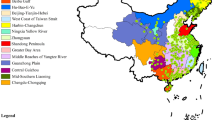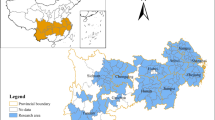Abstract
Significant differences in urban greening have occurred in Chinese cities, accompanied by China’s rapid urbanization. However, there are relatively few studies on the spatial differentiation of urban greening in China at the city level. In addition, there is no unanimous conclusion on the main factors influencing the spatial differentiation of urban greening. Based on 2014 emission inventory data from 289 cities, the spatial differentiation pattern and spatial correlation characteristics of the urban green space ratio, urban green coverage rate, and public green area per capita were calculated and analyzed using global and local Moran’s I. We then used ordinary least squares, spatial error model, spatial autoregression, and geographically weighted regression to quantify the impact and spatial variations of China’s economy on urban greening. The results showed (1) a significant spatial dependence and heterogeneity existed in urban greening values, and the patterns showed influences of both the stage of economic development and spatial agglomeration; (2) regression models revealed per capita GDP had a positive effect on the urban green space ratio and public green area per capita while the urbanization rate, secondary industry, urban land, and population density had opposite effects on these two greening indexes; and (3) geographically weighted regression revealed per capita GDP had a greater influence on urban greening in the northwestern region than in the southeastern region. The study could constitute a valuable reference for mid-to-long-term green space planning policy in diverse parts of China and could further assist in coordinating the development of urban greening and economic growth.








Similar content being viewed by others
References
Bardhan, R., Debnath, R., & Bandopadhyay, S. (2016). A conceptual model for identifying the risk susceptibility of urban green spaces using geo-spatial techniques. Modeling Earth Systems and Environment, 2(3), 144.
Barrera, F. D. L., Reyes-Paecke, S., & Banzhaf, E. (2016). Indicators for green spaces in contrasting urban settings. Ecological Indicators, 62, 212–219.
Beninde, J., Veith, M., & Hochkirch, A. (2015). Biodiversity in cities needs space: a meta-analysis of factors determining intra-urban biodiversity variation. Ecology Letters, 18(6), 581–592.
Brunsdon, C., Aitkin, M., Fotheringham, S., Charlton, E. (1999). A comparison of random coefficient modeling and geographically weighted regression for spatially non-stationary regression problems. Geographical and Environmental Modelling, 3(1), 47–62.
Byomkesh, T., Nakagoshi, N., & Dewan, A. M. (2012). Urbanization and green space dynamics in greater Dhaka, Bangladesh. Landscape and Ecological Engineering, 8(1), 45–58.
Crane, K., & Mao, Z. (2015). Costs of selected policies to address air pollution in China. RAND Corporation.
Fischer, M. M., & Getis, A. (2011). Handbook of applied spatial analysis: Software tools, methods and applications. Taylor & Francis, Inc.
Fotheringham, A. S. (2001). Spatial variations in school performance: a local analysis using geographically weighted regression. Geographical and Environmental Modelling, 5(1), 43–66.
Fry, G. L. A. (2001). Multifunctional landscapes—towards transdisciplinary research. Landscape and Urban Planning, 57(3–4), 159–168.
Fuller, R. A., & Gaston, K. J. (2009). The scaling of green space coverage in European cities. Biology Letters, 5(3), 352–355.
Jim, C. Y. (2004). Green-space preservation and allocation for sustainable greening of compact cities. Cities, 21(4), 311–320.
Li, H., & Liu, Y. (2016). Neighborhood socioeconomic disadvantage and urban public green spaces availability: a localized modeling approach to inform land use policy. Land Use Policy, 57, 470–478.
Li, C., Zhao, J., & Xu, Y. (2017). Examining spatiotemporally varying effects of urban expansion and the underlying driving factors. Sustainable Cities and Society, 28, 307–320.
Liu, G., Yang, Z., Chen, B., & Ulgiati, S. (2011). Monitoring trends of urban development and environmental impact of Beijing, 1999–2006. Science of the Total Environment, 409(18), 3295–3308.
Liu, Y., Yan, B., & Zhou, Y. (2016). Urbanization, economic growth, and carbon dioxide emissions in China: a panel cointegration and causality analysis. Journal of Geographical Sciences, 26(2), 131–152.
Liu, H., Fang, C., Zhang, X., Wang, Z., Bao, C., & Li, F. (2017). The effect of natural and anthropogenic factors on haze pollution in Chinese cities: a spatial econometrics approach. Journal of Cleaner Production, 165, 323–333.
Lozano, S., & Gutiérrez, E. (2008). Non-parametric frontier approach to modelling the relationships among population, GDP, energy consumption and CO2 emissions. Ecological Economics, 66(4), 687–699.
Ministry of Housing and Urban-Rural Development of China (2002a) Classification standard of urban green space (CJJ/T 85—2002). Beijing: China.
Ministry of Housing and Urban-Rural Development of China (2002b) Compendium of urban green space system planning. Beijing: China.
Ministry of Housing and Urban-Rural Development of China (2016) Series standard of National Garden City. Beijing: China.
National Bureau of Statistics of China. (2014). China City statistical yearbook. Beijing: Statistics Press.
Pauleit, S., Ennos, R., & Golding, Y. (2005). Modeling the environmental impacts of urban land use and land cover change—a study in Merseyside, UK. Landscape and Urban Planning, 71(2), 295–310.
Richards, D. R., Passy, P., & Oh, R. R. Y. (2017). Impacts of population density and wealth on the quantity and structure of urban green space in tropical Southeast Asia. Landscape and Urban Planning, 157, 553–560.
Rosa, D. L., Riccardo, P., Barbarossa, L., & Greca, P. L. (2017). Assessing spatial benefits of urban regeneration programs in a highly vulnerable urban context: a case study in Catania, Italy. Landscape and Urban Planning, 157, 180–192.
Seik, F. T. (2001). Planning and design of Tampines, an award-winning high-rise, high-density township in Singapore. Cities, 18(1), 33–42.
Sun, J., Wang, X., Chen, A., Ma, Y., Cui, M., & Piao, S. (2011). NDVI indicated characteristics of vegetation cover change in china’s metropolises over the last three decades. Environmental Monitoring and Assessment, 179(1–4), 1–14.
Tu, J., & Xia, Z. G. (2008). Examining spatially varying relationships between land use and water quality using geographically weighted regression I: model design and evaluation. Science of the Total Environment, 407(1), 358–378.
Vos, W., & Meekes, H. (1999). Trends in European cultural landscape development: perspectives for a sustainable future. Landscape and Urban Planning, 46(1), 3–14.
Wang, Y. C., Lin, J. C., Liu, W. Y., Lin, C. C., & Ko, S. H. (2016a). Investigation of visitors’ motivation, satisfaction and cognition on urban forest parks in Taiwan. Journal of Forest Research, 21(6), 261–270.
Wang, Z., Xu, X., & Liang, Z. (2016b). Industrial upgrade and economic governance in the Pearl River Delta—a case study of Dongguan city. China Finance and Economic Review, 4(1), 17.
Wendel, H. E. W., Zarger, R. K., & Mihelcic, J. R. (2012). Accessibility and usability: green space preferences, perceptions, and barriers in a rapidly urbanizing city in Latin America. Landscape and Urban Planning, 107(3), 272–282.
Williams, E. D., Gottfried, R. R., Brockett, C. D., & Evans, J. P. (2004). An integrated analysis of the effectiveness of Tennessee’s Forest Greenbelt Program. Landscape and Urban Planning, 69, 287–297.
Yang, J., Huang, C., Zhang, Z., & Wang, L. (2014). The temporal trend of urban green coverage in major Chinese cities between 1990 and 2010. Urban Forestry & Urban Greening, 13(1), 19–27.
Zhang, C., Lin, L., Xu, W., & Ledwith, V. (2008). Use of local moran’s I and GIS to identify pollution hotspots of Pb in urban soils of Galway, Ireland. Science of the Total Environment, 398(1–3), 212–221.
Zhang, H., Chen, B., Sun, Z., & Bao, Z. (2013). Landscape perception and recreation needs in urban green space in Fuyang, Hangzhou, China. Urban Forestry & Urban Greening, 12(1), 44–52.
Zhao, J., Chen, S., Jiang, B., Ren, Y., Wang, H., Vause, J., & Yu, H. (2013). Temporal trend of green space coverage in China and its relationship with urbanization over the last two decades. Science of the Total Environment, 442(1), 455–465.
Zhou, X., & Wang, Y. C. (2011). Spatial-temporal dynamics of urban green space in response to rapid urbanization and greening policies. Landscape and Urban Planning, 100(3), 268–277.
Funding
This work was supported by the National Natural Science Foundation of China (Grant No. 31670704), Research and Development Plan of Beijing Municipal Science and Technology Commission (Grant No. D17110900710000), China Postdoctoral Science Foundation (Grant No. 2018M630196) and State Key Laboratory of Subtropical Building Science (Grant No. 2017ZB09).
Author information
Authors and Affiliations
Contributions
Fangzheng Li contributed to the development of the idea and participated in all phases. Xiyue Wang, Haimeng Liu, Xiong Li, Yue Sun, and Xi Zhang helped perform the analysis with constructive discussion. Yuhong Wang helped improve the figures and manuscript. All authors have read and approved the final manuscript.
Corresponding author
Ethics declarations
Conflict of interest
The authors declare that they have no conflict of interest.
Rights and permissions
About this article
Cite this article
Li, F., Wang, X., Liu, H. et al. Does economic development improve urban greening? Evidence from 289 cities in China using spatial regression models. Environ Monit Assess 190, 541 (2018). https://doi.org/10.1007/s10661-018-6871-4
Received:
Accepted:
Published:
DOI: https://doi.org/10.1007/s10661-018-6871-4




